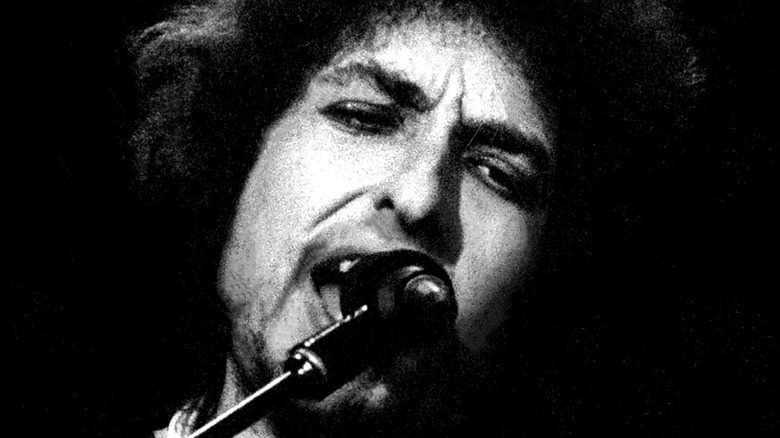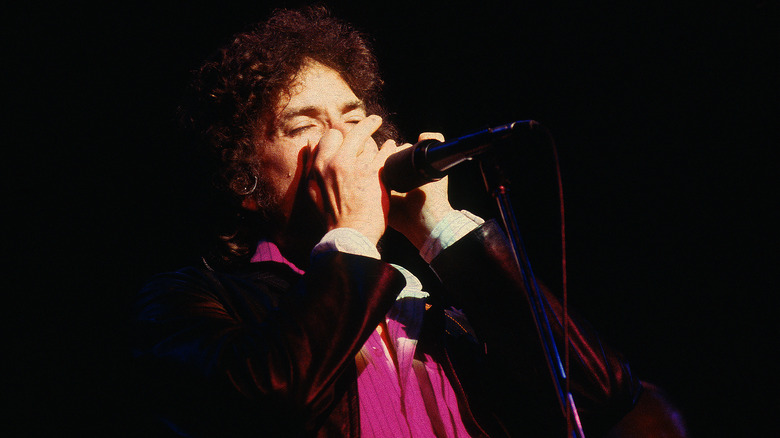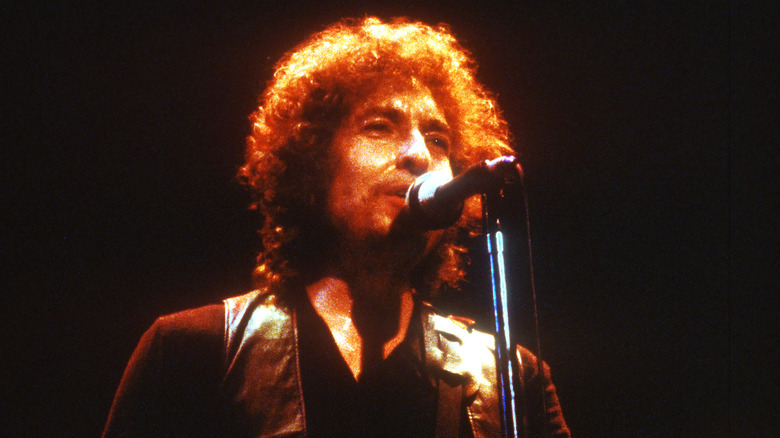The Apocalyptic Narrative Behind Bob Dylan's A Hard Rain's A-Gonna Fall
Americana singer and Academy Award winner Ryan Bingham once declared in his song "Dylan's Hard Rain," that "Mr. Dylan's Hard Rain is fair warning." By "Mr. Dylan," he was talking about folk legend/singer-songwriter Bob Dylan. The "hard rain" in question refers to Dylan's iconic anti-war anthem, "A Hard Rain's A-Gonna Fall." Throughout a good part of the twentieth century and on, Dylan compiled a depthless mass of songs that dedicated themselves to important social and ideological causes. War, executive abuse, protest, power, and police all had their place within his arsenal of music that earned him the Nobel Prize in literature back in 2016 (via Human Rights Watch).
Even those who aren't devout fans of the man probably know "The Times They Are A-Changin'," "Hurricane," and "Blowin' in the Wind" at least to a degree, but devout patriots of Dylan's music celebrate "A Hard Rain's A-Gonna Fall" as much as any of the others. The song appeared on his second studio album, "The Freewheelin'" in 1963 (per Discogs). Certain renditions by other notable artists have been recorded over the years, including a particularly popular version performed by the late Leon Russel in 1971. Rolling Stone magazine once called it "the greatest protest song by the greatest protest songwriter of his time." The track is widely understood to be a commentary on the nature of war and global violence, but there's a more intentional meaning at its core that you might not be aware of.
A Hard Rain's A-Gonna Fall speaks of the apocalypse
Believe it or not, there's something diabolical underneath the light-hearted and benevolent tone that characterizes the song's melody. "A Hard Rain's A-Gonna Fall" depicts a dystopian world that's been ravaged by war and unrelenting bloodshed. The prophetic word pictures that are emblematic of impending doom read like a portrait of poetic devastation. Children carrying guns in the streets, a tree oozing blood from its branches, and a baby encircled by a pack of ravenous wolves ... is this a folk song or an Orwellian cautionary tale (per The Guardian)?
Some have asserted that the song is reflective of the Cuban Missile Crisis of 1962, though no definitive confirmation from Bob Dylan or anyone else has ever ascertained this. However, Dylan did credit much of the song's inspiration to "Lord Randall," a timeless, tragic folk ballad that the songwriter admired at the time. "Lord Randall" recounts the story of a mother beseeching her son to reveal where he has been throughout the course of his absence from home — hence Dylan's commencement of the track with, "Where have you been my blue-eyed son" (via Song Facts)?
Bob Dylan changed the original version of the song
Like most songs, "A Hard Rain's A-Gonna Fall" went through a sort of creative metamorphosis in its early stages. Bob Dylan reportedly went back and changed various lines and phrases multiple times before he was satisfied with the final product. "You can see it was not originally intended as a working draft," said Gabriel Heaton, a manuscript specialist. "It was meant to be a final version of the song but when he starts reading it again, he clearly is unhappy with it and starts reworking, starts revising ... more ideas start spilling out of his brain." The manuscript in question was an early draft of the song's lyrics with various annotations inscribed by Dylan himself (via The Guardian).
"Six purple mountains" was later changed to "12 misty mountains." "My blue-eyed boy" became "My blue-eyed son." Likewise, "My darling young son" became "My darling young one" (per The Guardian). While these subtle nuances may seem minuscule to certain listeners, even the subtlest of variations matter to songwriters devoted to their craft. Bob Dylan is perhaps the most pedantic of them all. That's probably why he's often referred to as the greatest songwriter of all time.


